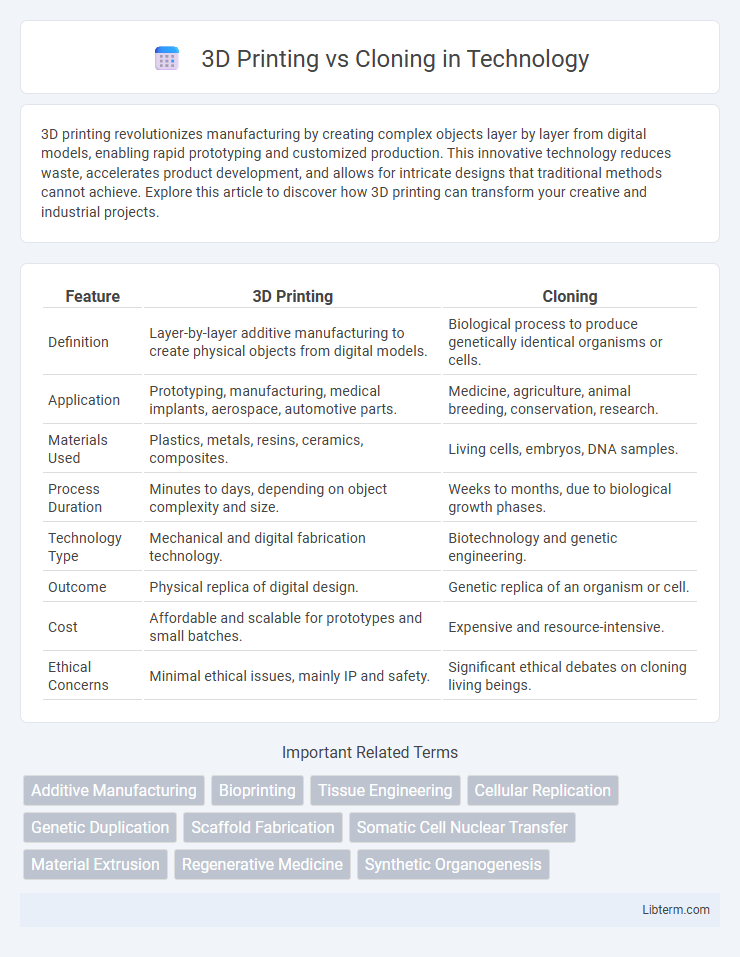3D printing revolutionizes manufacturing by creating complex objects layer by layer from digital models, enabling rapid prototyping and customized production. This innovative technology reduces waste, accelerates product development, and allows for intricate designs that traditional methods cannot achieve. Explore this article to discover how 3D printing can transform your creative and industrial projects.
Table of Comparison
| Feature | 3D Printing | Cloning |
|---|---|---|
| Definition | Layer-by-layer additive manufacturing to create physical objects from digital models. | Biological process to produce genetically identical organisms or cells. |
| Application | Prototyping, manufacturing, medical implants, aerospace, automotive parts. | Medicine, agriculture, animal breeding, conservation, research. |
| Materials Used | Plastics, metals, resins, ceramics, composites. | Living cells, embryos, DNA samples. |
| Process Duration | Minutes to days, depending on object complexity and size. | Weeks to months, due to biological growth phases. |
| Technology Type | Mechanical and digital fabrication technology. | Biotechnology and genetic engineering. |
| Outcome | Physical replica of digital design. | Genetic replica of an organism or cell. |
| Cost | Affordable and scalable for prototypes and small batches. | Expensive and resource-intensive. |
| Ethical Concerns | Minimal ethical issues, mainly IP and safety. | Significant ethical debates on cloning living beings. |
Introduction: Defining 3D Printing and Cloning
3D printing is an additive manufacturing process that creates three-dimensional objects by layering materials based on digital models. Cloning involves producing genetically identical organisms or cells through techniques like somatic cell nuclear transfer or molecular cloning. Both technologies rely on precise replication but differ fundamentally in their applications--3D printing focuses on physical objects, while cloning targets biological entities.
Historical Background: Evolution of Both Technologies
3D printing began in the 1980s with Chuck Hull's invention of stereolithography, revolutionizing manufacturing by enabling rapid prototyping and complex geometries. Cloning, rooted in biological science, advanced significantly after the 1996 success of Dolly the sheep, demonstrating the feasibility of mammalian cloning through somatic cell nuclear transfer. Both technologies have evolved through decades of research, with 3D printing progressing towards bioprinting tissues and cloning expanding ethical and scientific boundaries in genetics.
Core Principles: How 3D Printing Works vs. Cloning
3D printing operates by layering material based on digital models to create physical objects through additive manufacturing technology. Cloning involves replicating an organism's genetic material to produce a genetically identical copy through biological processes such as somatic cell nuclear transfer. While 3D printing relies on computer-aided design and material extrusion, cloning depends on cellular biology and DNA replication mechanisms.
Applications in Medicine: Organ Transplants and Tissue Engineering
3D printing enables precise fabrication of organ scaffolds and customized tissue structures, accelerating advancements in organ transplants and tissue engineering by providing biocompatible materials tailored to patient-specific anatomy. Cloning facilitates the replication of entire cells or tissues, offering potential for creating genetically identical organs, which could reduce transplant rejection risks but faces ethical and technical challenges. Combining 3D bioprinting with cloning technologies enhances regenerative medicine efforts by integrating cellular replication with structural bioengineering, promoting the development of functional transplantable organs.
Ethical Concerns: Morality of 3D Printing vs. Cloning
The ethical concerns surrounding 3D printing center on intellectual property rights and potential environmental impact, whereas cloning raises profound questions about identity, human rights, and the sanctity of life. Unlike 3D printing, which primarily replicates objects based on digital files, cloning involves creating genetically identical organisms, invoking debates on consent and the moral implications of human reproduction. Both technologies challenge societal norms, but cloning presents more complex dilemmas related to personal autonomy and ethical bioengineering.
Limitations and Challenges: Technical Hurdles Compared
3D printing faces technical challenges such as limited resolution, material constraints, and difficulties in replicating complex biological tissues, restricting its ability to produce fully functional organs. Cloning encounters genetic and epigenetic hurdles, including incomplete DNA replication and high rates of developmental abnormalities, posing significant risks to viability. Both technologies require advanced biocompatibility solutions and face ethical considerations, but cloning's biological complexity presents more profound scientific and regulatory challenges.
Cost and Accessibility: Economic Impacts of Each Technology
3D printing offers more affordable and accessible solutions for manufacturing prototypes and custom products due to lower material costs and widespread availability of printers. Cloning remains prohibitively expensive, involving complex laboratory procedures and ethical regulations that limit accessibility primarily to specialized scientific institutions. The economic impact of 3D printing drives innovation in small businesses and education sectors, while cloning's high cost restricts its influence primarily to medical and research advancements.
Regulatory Landscape: Legal Status and Oversight
The regulatory landscape for 3D printing involves established frameworks centered on intellectual property rights, product safety, and manufacturing standards, with agencies like the FDA overseeing medical device printing. In contrast, cloning faces stringent legal restrictions and ethical scrutiny, with many countries imposing outright bans or strict licensing due to concerns about human rights and biodiversity. Oversight bodies for cloning include specialized bioethics committees and international treaties such as the Convention on Biological Diversity, ensuring rigorous control over cloning practices.
Future Prospects: Innovation and Integration Paths
Future prospects in 3D printing emphasize advancements in bioprinting tissues, customizable prosthetics, and complex manufacturing, driving innovation in personalized medicine and industry automation. Cloning research focuses on genetic preservation, species conservation, and potential therapeutic cloning applications, integrating biotechnology with ethical frameworks and regulatory developments. The convergence of 3D printing and cloning technologies may unlock new pathways for organ regeneration, synthetic biology, and enhanced life sciences innovation.
Conclusion: Weighing the Benefits and Risks
3D printing offers precise, customizable manufacturing solutions with minimal material waste, making it ideal for prototyping and medical applications, while cloning raises ethical concerns related to identity and biodiversity. Both technologies carry risks: 3D printing faces intellectual property challenges and potential misuse, whereas cloning involves complex biological risks and moral debates. Weighing these factors requires balancing innovation potential against ethical responsibility and regulatory frameworks to ensure safe and beneficial outcomes.
3D Printing Infographic

 libterm.com
libterm.com